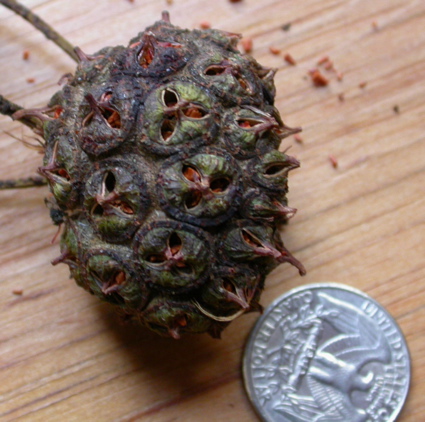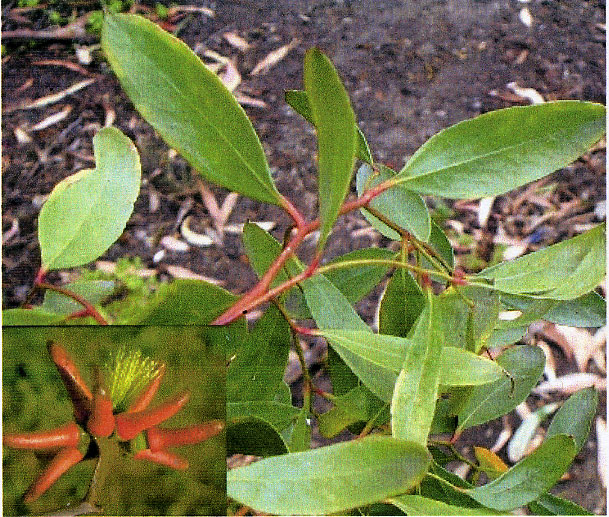Eucalyptus conferruminata
 Spider gum, Bald Island marlock
Spider gum, Bald Island marlock
When the need arises for a screen tree that bears foliage down to ground level, is not much more than 12 feet tall (though can eventually grow to double that height), spreads as a screen to more than 10 to 20 feet across, tolerates low rainfall, does not mind wind loaded with salt spray, can grow on salty mudflats, and ignores the calcareous accumulation of ages of small shellfish, one turns to the spider gum. Thousands had been planted to hold back the wind and spray and to hide the desolate wetlands as we drive to San Francisco Airport on Bayshore Freeway; hundreds remain. Scores have been planted along North Shoreline Boulevard in Mountain View as it curves around Shoreline Golf Links. There are thousands more through Berkeley and beyond and on Highway 101 around Santa Barbara. Punctuated at intervals by taller river red gums that catch the eye, the low unclipped hedge of spider gums passes virtually unnoticed – until you learn to notice the distinctive glint of the light green leaves against older growth.
The fallen opercula are long, narrow, smooth, curved horns that are red on the sunlit side but otherwise yellow. They are usually large enough for kids to fit on their fingertips like thimbles and play “witches’ fingers.” A spider gum should be grown in every primary school playground. E. conferruminata has been mistakenly sold as E. lehmannii, bushy yate, for many years. To add to the confusion, different forms of spider gum have been observed in the Bay Area differing mostly by the proportions and size of the mature opercula; these may be different subspecies.
The most commonly encountered specimen on campus grows on the northwestern corner of the Galvez modules. See three other trees, one with large straight opercula and two with thin curved opercula, on Serra Street a few yards north of the Recycling Center driveway.
Oregon Expressway was lined on one side by spider gums until the road was widened. Three substantial multi-trunked 30-foot high specimens remain on the north side of 2411 High Street, Palo Alto. Others can be seen opposite Oregon Expressway from them, along the cloverleaf near the park. The branches droop close to ground level, as appropriate for a windbreak. If you examine a few untended trees it will strike you that the habit of having foliage to ground level results from natural splitting of lower branches to form props; the effect of this in the wild is to steady the whole plant against windthrow.
Tree people will have noticed that each eucalypt tends to have 1, 3, 7, or 15 buds, following the formula 2ⁿ-1, where n may vary from 1 to 5. Spider gum often has 15 and in other cases tries to reach 31 but at the higher numbers some buds may fail to develop. The fruits fuse together (conferruminata means welded together) to form irresistible collectibles that can be as big as a fist and are suitable for dry arrangements.
Sunset magazine had run an article advocating the spider gum as an accent tree for small gardens and showed a specimen pruned to a small erect form.
Related material: Eucalyptus checklist.
About this Entry: The main text of this entry is from the E. lehmannii entry in the book Trees of Stanford and Environs, by Ronald Bracewell, published 2005. John Rawlings subsequently added Shoreline Golf Links location and noted the confusion between that species and L. conferruminata (ref. Sunset). Entry changed to describe E. conferruminata only – E. lehmannii has been widely misapplied to this species; Galvez modules location added; edits (Feb 2024, SP).






